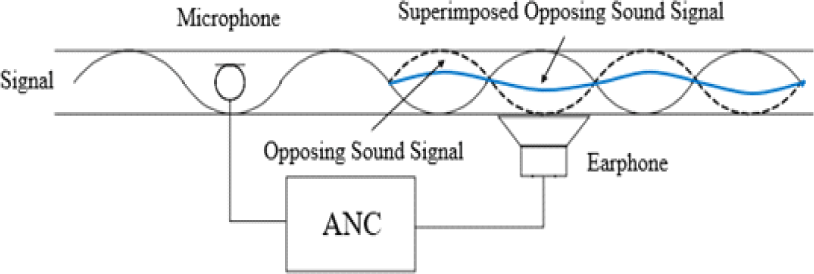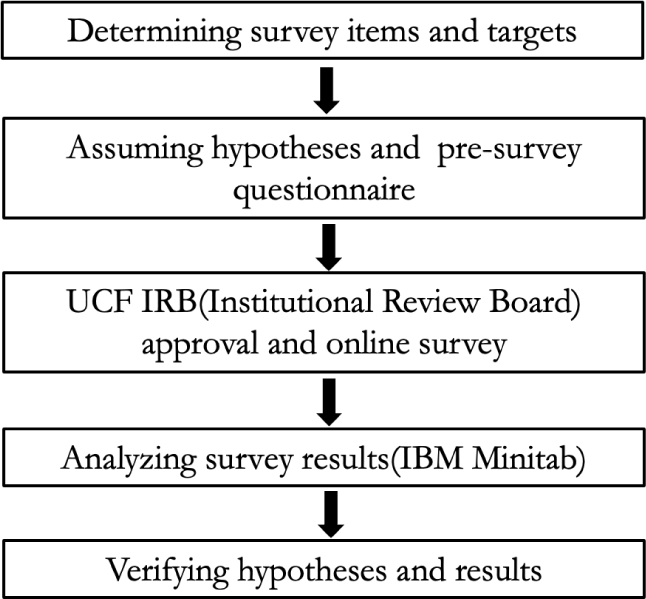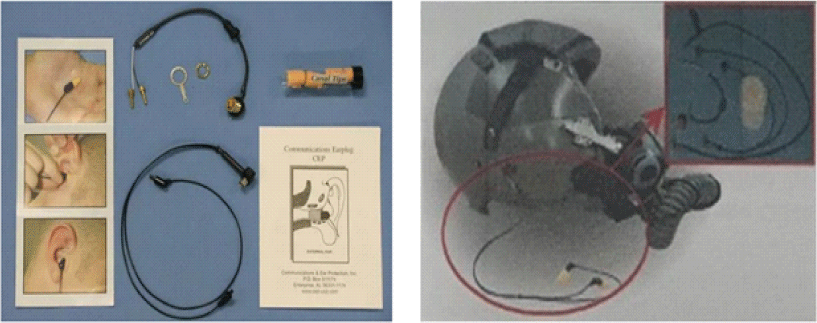I. INTRODUCTION
Air Force pilots have suffered from extreme cockpit noise. While the noise levels of commercial aircraft have been decreased, the noise levels of tactical fighter jets have been increased due to the requirement for more thrust and maneuvering performance on the battlefield. The cockpit of a fighter jet is extremely noisy and its average levels range from 95 to 105 dB (Bharath et al., 2016). This value exceeds the permissible exposure limit of OSHA’s (Occupational Safety and Health Administration) noise standard of 90 dB.
The extreme noise in the cockpit has been perceived as a severe problem since the noise can take a toll on pilots physiologically and psychologically (James, 2005).
The physiological effects of noise are ear discomfort, ear pain, eardrum rupture, hearing impairment, Temporary Threshold Shift (TTS), and Permanent Threshold Shift (PTS) (Ivošević et al., 2016). In addition, non-auditory physiological effects of excessive noise include various subjective symptoms such as lethargy, anxiety, headaches, dizziness, nausea, stress, fatigue, or irritability (Ivošević et al., 2016).
The psychological effects of noise are stress, loss of attentiveness, memory shortage, and an increase in error rate (Jang et al., 2014). Since pilots are already flying under a lot of stress with a responsibility to achieve aviation safety, the level of stress that pilots feel can deteriorate more rapidly when it is combined with noise-induced stress (Lee and Cho, 2022). Additionally, Muhr et al. (2019) mentioned that cockpit noise can lead to prolonged reactions and poor alertness.
These adverse effects can significantly impact Air Force pilots' hearing health as well as their sensory, cognitive, and perceptual capabilities. Hence, the high level of noise can cause degraded pilot performance which can jeopardize aviation safety. Some pilots in the ROKAF have reported that they have encountered several risky situations caused by excessive cockpit noise while flying. The disturbance of radio communication with the Air Traffic Controller (ATC) or co-pilots caused by extreme cockpit noise put them in dangerous situations, and some of them barely avoided a crash with other aircraft in the adjacent airspace.
The ROKAF introduced the PNC devices into conventional pilot helmets to handle the negative effects; however, it has not been proven yet whether it is effective. Furthermore, compared to cargo/helicopter pilots who use aviation headsets with ANC, most fighter pilots except for F-35 pilots are still using conventional helmets without ANC.
The study aimed to not only analyze the pilot’s recognition of cockpit noise and noise cancellation technology, but also suggest the use of ANC system in conventional aviation helmets.
The primary contribution of the study is to improve the noisy environment in the cockpit and to enhance aviation safety through the application of the ANC system into the conventional helmets. Moreover, the study not only provides a comprehensive understanding of cockpit noise, but also demonstrates its effectiveness and usefulness when ANC techniques are applied to fighter pilot helmets.
II. THEORETICAL BACKGROUNDS
Air Force pilots are inevitably exposed to both external and internal noise. Lindvall and Västfjäll (2013) found that many factors such as wind pressure against airframe, fuselage, engines, radio equipment, general speech, air conditioning system, cabin pressurization, and electric equipment and aviation instrument contribute to the high level of noise. In addition, warning and caution signals also make cockpits a noisy environment.
The external noise can be generated by friction with protuberance such as fuselage, wings, missiles, IR sensors, refueling probes, etc. The noise levels caused by external airflow rely on the dynamic pressures on aircraft.
The internal noise is generated by not only the air conditioning system, pressurization system, caution and warning system, and radio communication, but also external airflow. Noise caused by the cockpit conditioning system from F-16 is dominated by both low-frequency and high-frequency sounds (James, 2005).
Noise exposure levels in military aircraft are higher than in civil aircraft. According to the research about the correlation between the total flying time and aircraft types regarding pilot’s hearing impairment, the more pilots have flown, the higher pilot’s hearing impairment (Lee and Jung, 2002).
James (2005) mentioned that air crews exposed to high levels of noise without adequate protection could suffer permanent hearing damage, and they could be excluded from flight mission, resulting in the cost of retraining and training for new crews.
According to the research from Yong and Wang (2015), in the military population, considerable hearing impairment and tinnitus can be found compared to the general public. The existence of tinnitus and hearing damage can adversely affect a pilot’s capability to hear crucial acoustic cues or radio communication with Ground Controlled Approach (GCA) or co-pilots. Listening is a key part of recognizing the situations to accomplish military missions as well as to foster aviation safety.
Air Force pilots are required to have alertness, vigilance, readiness, and attentiveness during military tasks. All flight procedures are involved reporting and approval with the Weapons Assignment Officer (WAO), Air Traffic Controller (ATC), and co-pilots. Smith (1990) found that noise can have an adverse effect on cognitive task performance. According to the research, the effects of loudness on human performance and safety are considerable; therefore, extreme cockpit noise can lead to compromising pilot performance and increasing the number of errors in any mission. Waye et al. (2001) conducted a study to figure out whether low-frequency noise can affect performance and subjective reaction. The result supported that low-frequency noise can influence pilot performance and increase the reaction time on a verbal analytical task.
Since noise has a wide range of effects such as interference with cognitive and perceptive thought processes, excessive cockpit noise can degrade information processing. The degraded pilot performance can severely affect aviation safety and mission achievement since cognitive and perceptive processing is crucial factors in any task; therefore, impaired performance such as delayed reaction time and unintelligibility can result in mission failure.
While visual cues are prevailing in the cockpit, impeccable perception and understanding of communication with WAO, ATC, and co-pilots are essential for aviation safety. The speech unintelligibility associated with a masking effect in a noisy environment where low-frequency sound is predominant can lead to safety issues (Kyuronen, 2004).
McFadden and Towell (1999) clearly elaborated that pilot errors caused by excessive noise can threaten aviation safety. Extreme cockpit noise can distract pilots and increase the number of errors in maintaining direction, altitude, and speed through communication with ATC.
Loss of concentration, delayed reaction time, decreased alertness, and memory shortage that are directly related to pilot performance can take a toll on flight safety (Ivošević et al., 2016). The aviation safety is first and foremost in the ROKAF; however, without sufficient and proper protectors to minimize the noise effects, it is unlikely to achieve it.
Conventional PNC technology has been used to keep human ears from a noisy environment. Conventional types of hearing protectors are earmuffs, ear canal caps, and earplugs. Passive hearing protectors can achieve noise reduction by absorbing, dissipating, and impeding energy flow through materials, and they can provide 30-35 dB of noise attenuation (Kroemer, 2017).
Although PNC devices are effective at the medium and high-frequency bands of sounds, passive reduction methods are inefficient at low frequencies where a wide range of noise energy is concentrated (Miljkovi´c, 2016). Therefore, the technology that can cope with low-frequency is necessary to control itself.
Unlike the conventional approach to reducing noise, ANC technology attempts to attenuate the noise level at the ear canal by creating a sound that is 180 degrees out of phase with the original one so that the combination achieves cancellation of the noise (Jang et al., 2014). ANC enables human ears to hear important sounds while reducing the level of noise, particularly, at low frequencies (Miljkovi´c, 2016). Fig. 1 visually presents how the ANC system cancels out unwanted sound or noise by making an opposing sound signal to create the superimposed signal.
Since the ANC method is effective for low-frequency noise, an appropriate combination of the PNC and ANC methods is useful for attenuating both high and low frequencies (Oinonen, 2006). In other words, ANC has a capability for noise suppression in an area of lower frequency noise that can make communication unambiguous and augment attentiveness.
Cargo aircraft, helicopter, and surveillance aircraft pilots in the ROKAF have taken advantage of noise reduction headsets with well-designed and good fitting-cups, and fighter jet pilots have used aviation helmets made of epoxy resin shells and ear cups. The use of passive and conventional hearing protectors is simple, inexpensive, and operationally effective to protect hearing health.
Insertable-type earplugs and earmuffs are main types of passive hearing protectors for Air Force pilots. Pääkkönen et al. (2000) found that the noise reduction level varied from 16 to 23 dB(A) when ear plugs were tested against heavy noise. In addition, an aviation helmet could provide a noise attenuation of approximate 50 dB (Pääkkönen et al., 2000).
In aviation environments, passive hearing protectors provide desirable features for reducing high-frequency noise, but, it can sometimes interfere with useful information and communication (James, 2005).
The innovative way to improve hearing protection for Air Force pilots is the ANC system, which is installed in the earmuffs of a headset or an aviation helmet. Wheeler et al. (1978) mentioned that conventional and passive hearing protectors might not be capable of providing sufficient noise attenuation; hence, the application of an additional noise reduction method is required to increase intelligibility.
The noise reduction of active hearing protection is achieved electronically, not solely mechanically, due to the fact that seal compression force of earcups and earmuffs does not require great force; hence, active hearing protectors can be more comfortable (Perala, 2006).
The study under Air Combat Maneuvering (ACM) mission revealed that when the ANC system is on, the average noise exposure was decreased by 10 to 15 dB over the noise attenuation of the same helmets with ANC off (Pääkkönen et al., 2001). In addition, they studied subjective evaluation from test pilots, and they preferred to perform missions with the ANC system because speech recognition was greatly improved even with lower-than-normal volume settings (Pääkkönen et al., 2001).
III. METHODOLOGY
The purpose of the study was to investigate whether Air Force pilots have experienced a risky situation due to extreme cockpit noise and to analyze the recognition of passive hearing protectors (CEP900-K04) and the effectiveness of ANC during the flight.
The survey questions are devised to examine demographic information, the experience of noise exposure during flight, the impacts of noise during flight, the effectiveness of passive hearing protectors some fighter pilots have used, and the effectiveness of ANC. Active F-35 instructor pilot and CN-235 instructor pilot verified the appropriateness of the questionnaire, and the professor in the School of Public Administration at the University of Central Florida (UCF) verified whether each question has no issues with respect to suitability, adequacy, and validity. After the thorough and comprehensive verification process, the survey was distributed to Air Force pilots in the ROKAF. The overall research process is described in Fig. 2.
A total of 154 pilots in the ROKAF responded to the survey. The survey was distributed to them regardless of the specific types of aircraft they currently fly to achieve anonymity and objectiveness. The participation in the survey was completely voluntary.
The questionnaire included demographic information of participants, the experience of noise exposure, and its impacts on hearing health, pilot performance, and aviation safety. In addition, questions were devised to investigate the pilot’s recognition about whether a passive hearing protector (Fig. 3) is effective as well as whether headsets and helmets with ANC have contributed to aviation safety.
Some physiological effects that can occur during the flight are lethargy, anxiety, headaches, dizziness, nausea, stress, fatigue, or irritability (FAA, 2022). Thus, the 1st hypothesis was assumed.
1) Hypothesis 1: Air Force pilots who currently fly with ANC recognize that it has helped to prevent the physiological effects compared to when they flew without it.
Since noise can take a toll on the pilot’s psychological condition which can cause loss of concentration, a decrease in sharpness and perception, poor decision-making process, prolonged reaction, and memory shortage), ANC could prevent the psychological effects. Therefore, the 2nd hypothesis is assumed.
The responses were analyzed to verify the hypotheses. 7-point Likert Scales were used to figure out the level of agreement regarding subjective questions. Values between –3 to 3 were replaced with values 1 to 7 to analyze the data (1=strongly disagree, 7=strongly agree).
Microsoft Minitab Statistical software was used to analyze the survey data, and a p-value less than 0.05 was considered statistically significant.
IV. SURVEY ANALYSIS
A total of 154 Air Force pilots in the ROKAF responded to the survey. The notable fact in Table 1 is that fighter pilots accounted for 87% of the total respondents since fighter pilots take more interest in the use of the ANC system rather than those who already have used ANC. Out of 154 respondents, pilots with 31-40 age accounted for more than 77%. It was founded that 61.7% of survey participants were instructor pilots who have more diverse flight experiences. Due to the number of experienced pilots, over 50% of respondents had over 1,000 flight hours.
Out of 154 pilots, 136 respondents (88.3%) had an experience of saying “SAY AGAIN” to WAO, ATC, or co-pilots due to noise, and 78% of respondents had at least a communication issue with them. However, the question about an experience of a risky situation caused by noise revealed that about 27% of respondents had a dangerous situation. It was concluded that even though many pilots have communication issues, they do not consider that noise significantly contributes to a risky situation during the flight.
As described in Table 2, about 27% of respondents thought that noise could impair pilot performance during missions in Military Operation Area (MOA) and about 25% of respondents thought that noise can adversely affect aviation safety during a flight in a Control Area (CTA). Since a lot of communication is required to achieve the mission objectives in MOA, the mission in MOA was considered the riskiest flight phase. Especially, fighter jets are frequently required to use high-power setting while maneuvering. Also, in a CTA that is the volume of controlled airspace in the vicinity of an Air Base, military aircraft and commercial planes coexist; thus, accurate communications are needed.
Table 3 shows the result of the survey. It was found that pilots’ hearing health has been impaired since they flew. Over half of the respondents agreed that noise has an adverse impact on hearing health.
The pilot’s recognition of the effectiveness of ANC toward the physiological effects was statistically analyzed by the paired t-test. It was found that there was no significant statistical difference (p-value=0.402); Therefore, the 1st hypothesis was rejected. Air Force pilots who fly with aviation headsets or helmets with ANC did not recognize that it has helped to prevent the physiological effects (lethargy, anxiety, headaches, dizziness, nausea, stress, fatigue, or irritability).
The questionnaire also includes questions to investigate the pilot’s cognitive status on the psychological impacts of noise (loss of concentration, the degrease of sharpness of perception, deteriorated judgment and poor decision making, prolonged reaction, and memory shortage). The survey result showed that over 50% of respondents agreed that noise has adverse effects on Air Force pilots’ psychological condition. The pilot’s psychological state can negatively affect the pilot’s performance, which can soon hinder the aviation safety. Therefore, cockpit noise must be controlled to a level that does not degrade the pilot’s performance.
According to a survey of 47 fiighter pilots using aviation helmet with PNC (CEP900-K04), the current PNC device was expected to satisfy pilots in terms of aviation safety, but their perception did not show that it had any exceptional effects. About 40% of respondents answered “Neutral” when it comes to the recognition of the effectiveness of PNC on mission achievement, and less than 30% of respondents positively agreed that the current PNC device is effective with respect to aviation safety.
Nowadays, due to the popularity and usefulness of ANC technology in the industry, the use of cutting-edge headphones or headsets with an ANC system is not unusual for the public. From the survey result (Fig. 4), out of 154 respondents, 113 (73.4%) pilots have used commercial earphones or headsets with ANC systems such as AirPod Pro, Galaxy Buds, or Boss Sleepbuds.
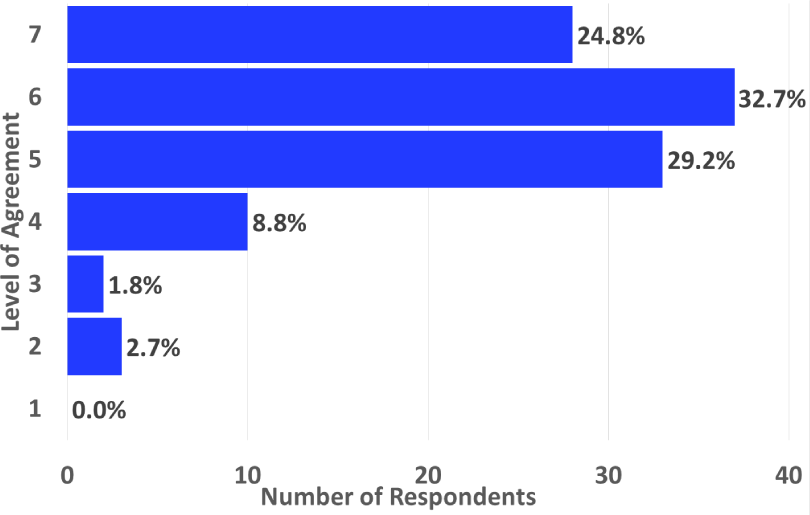
Approximate 85% of respondents positively thought that ANC could contribute to the pilot’s hearing health. The pilot's recognition of the effectiveness of the ANC system supports that if ANC technology were extensively employed, hearing impairment caused by cockpit noise could be reduced.
Fig. 5 shows how pilots who have used commercial earphones or headsets with the ANC system recognize its effectiveness if it is applied to aviation headsets or helmets in terms of pilot’s performance and aviation safety. Over 80% of pilots positively agreed on the effectiveness of ANC system. The Air Force pilot's recognition is critical because they are actual users. Their previous experience in using ANC technology can be beneficial if the ANC system is employed in flight headsets or helmets. Thus, it is likely that ANC could play a crucial role in pilot performance which is directly related to aviation safety.
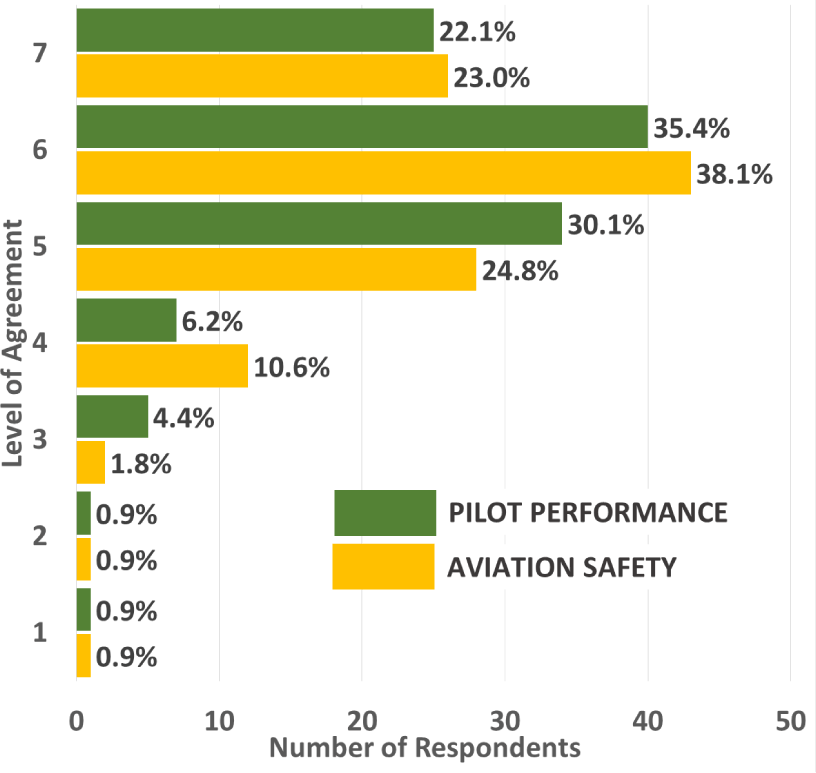
Additional responses for questions 14 to 18 about the psychological effects of performance were statistically analyzed to inspect whether ANC currently employed has contributed to the robust pilot performance compared to when pilots flew with aviation headsets or helmets without ANC. Each question asked participants twice to investigate the effectiveness of ANC before and after the use of it. As shown in Table 4, the paired t-test result revealed that noise has little impact on pilot performance when pilots fly with ANC (p-value<0.001). Therefore, the difference between before and after the use of ANC was statistically significant. Thus, the 2nd hypothesis was not rejected. In light of the analysis, ANC-equipped headsets and helmets can help to strengthen aviation safety, as they can mitigate the damage noise can cause to pilots, including the aviation safety can be more robust because the aviation headset and helmet with ANC can mitigate loss of concentration, loss of perception, poor decision-making, prolonged reaction, and memory shortage.
V. DISCUSSION AND CONCLUSION
In the first analysis of the noise exposure experience, nearly 80% of respondents had a communication issue caused by extreme cockpit noise. Approximately 30% of respondents had a risky situation due to noise. Clear speech recognition is indispensable during the flight since even a small misunderstanding of communication with WAO, ATC, or co-pilots can threaten mission success and flight safety. Especially, in military aviation, the importance of impeccable understanding of communication cannot be overlooked since it can result in unintentional or incidental damage to civilians or objects that are not considered military targets.
In the second analysis regarding the physiological impact of noise, over 50% of Air Force pilots recognized that their hearing health has been impaired. The paired t-test revealed that Air Force pilots do not recognize that aviation headset or helmet with ANC has prevented the physiological effects during the flight. Since the flight environment has a complex physiological effect on the pilot, it is determined that estimating only the effects of noise is impossible through the questionnaire.
In the third analysis of the psychological effects of noise, most Air Force pilots recognized that noise can adversely affect their psychological conditions. Since pilot’s psychological state is directly related to performance, noise can put the mission itself in jeopardy. Hence, extreme cockpit noise should be alleviated by the use of active noise reduction technology so that Air Force pilots can fly safely and achieve missions.
The fourth analysis of the effectiveness of a passive hearing protector (Fig. 3) indicates that it has not significantly contributed to pilot performance and aviation safety. Among 114 fighter pilots, about 40% of them who have used it recognized that despite the use of the PNC device, it does not have such a beneficial effect. Since PNC has limitations in environments where low frequencies are prevalent, it is shown that current PNC devices are highly unlikely to help control noise directly related to pilot performance and aviation safety.
In the last analysis about the Air Force pilot’s recognition of the effectiveness of ANC, pilots who had experience using a commercial ANC device positively responded that ANC could contribute to the prevention of hearing impairment. Additionally, they also recognized that widespread application of ANC to aviation headsets and helmets could significantly reduce the negative effects of noise. Furthermore, the paired t-test indicates that using ANC systems significantly reduces the likelihood of poor pilot performance.
Due to the nature of Air Force pilots, many of them still have no choice but to rely solely on the PNC, despite the inevitable exposure to various noises during flight. The effects of extreme cockpit noise not only greatly affect auditory health and pilot performance, but also impair flight safety. Therefore, the use of ANC technology in all aviation headsets and helmets in the Air Force can make a huge difference in pilot performance, which plays a crucial role in mission accomplishment and aviation safety. In particular, low-frequency noise can be attenuated by applying ANC systems, so using PNC and ANC together can dramatically reduce the side effects of noise.
Being an Air Force pilot is a complex job with a myriad of responsibilities. The ANC system will not only make it easier and less stressful to perform air missions but will also make pilots more vigilant, cautious, and safe.








